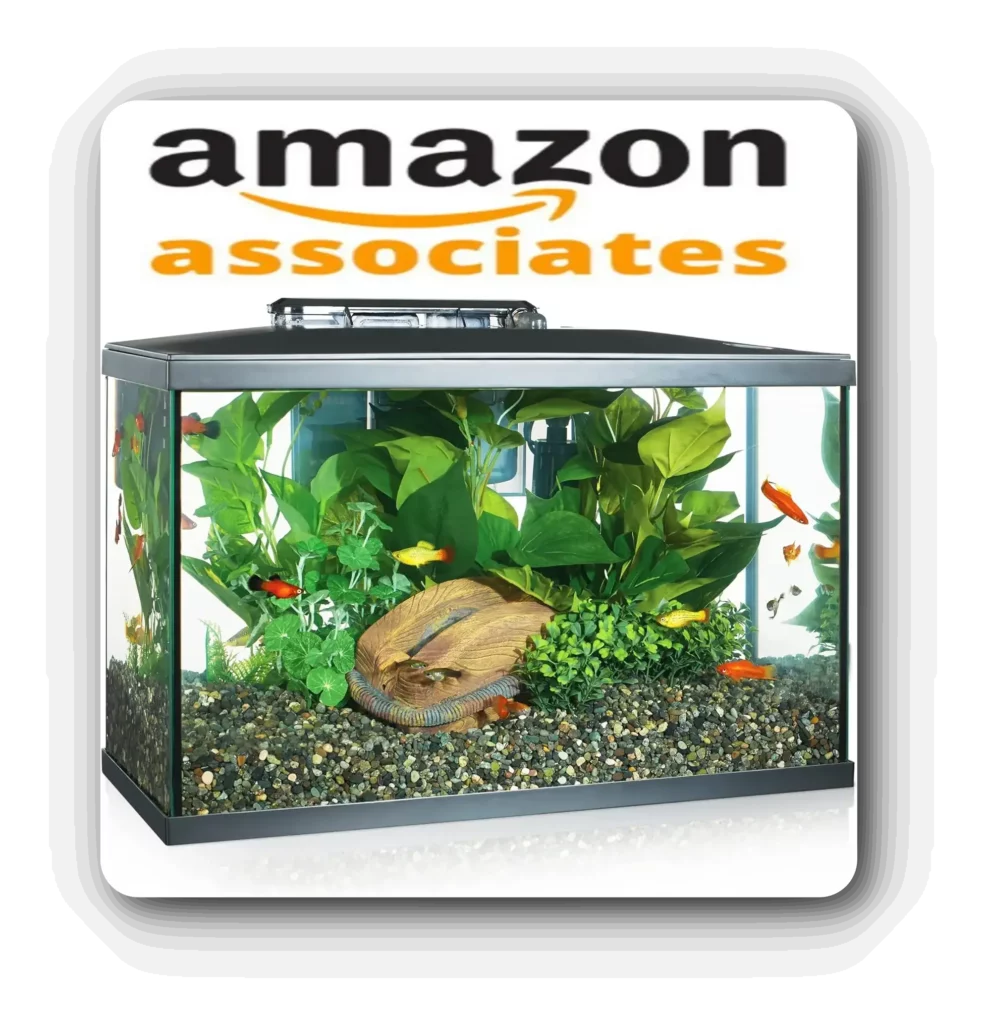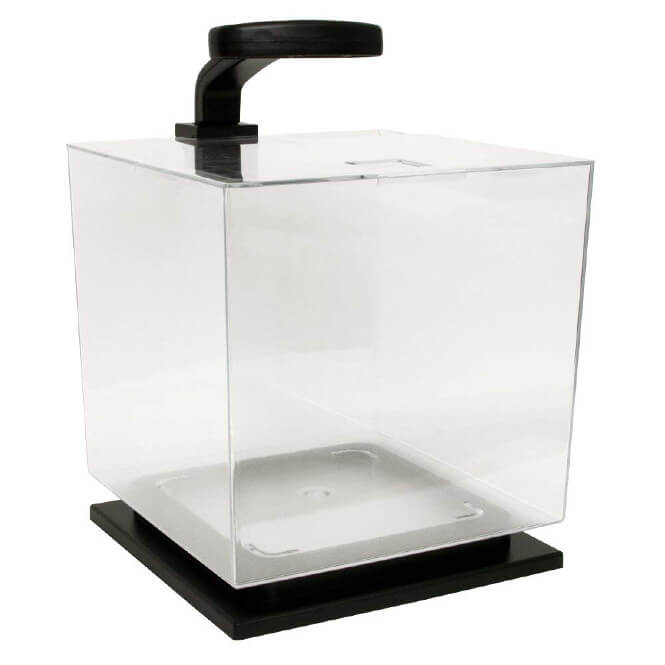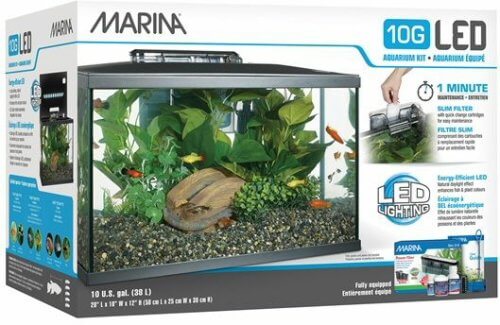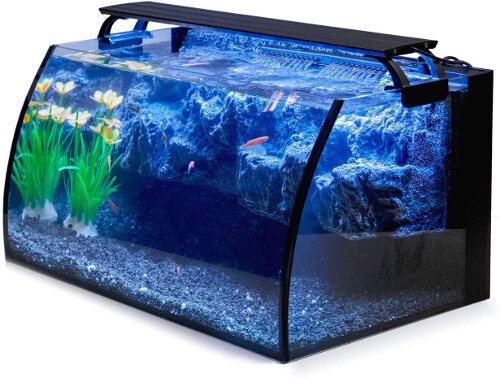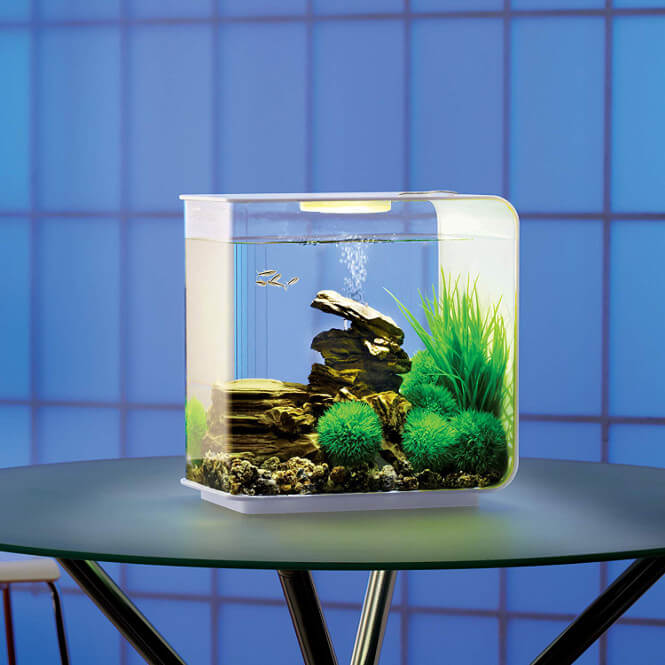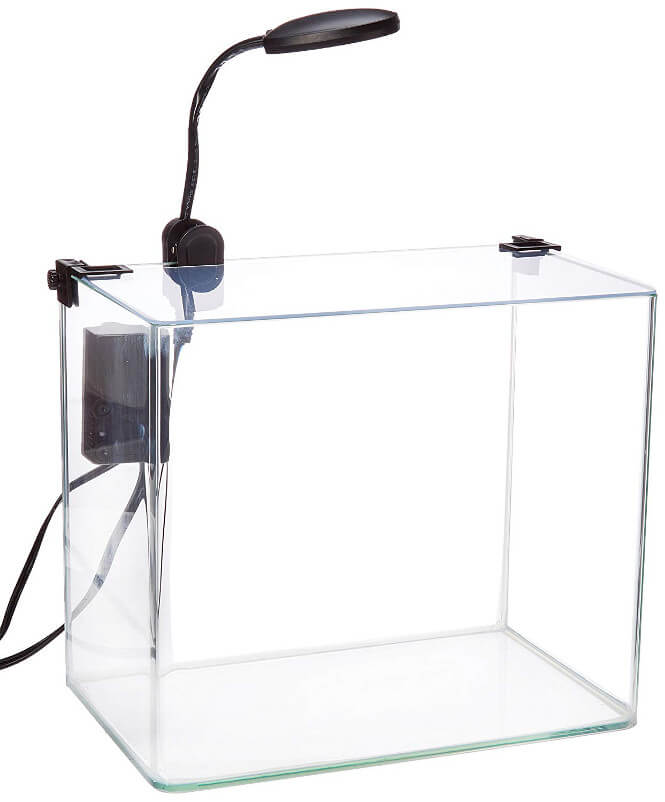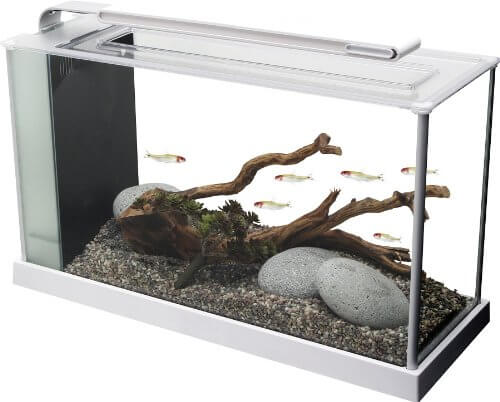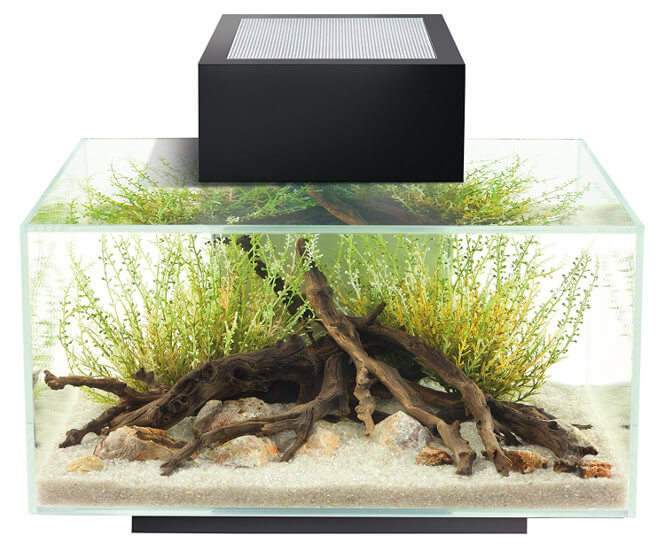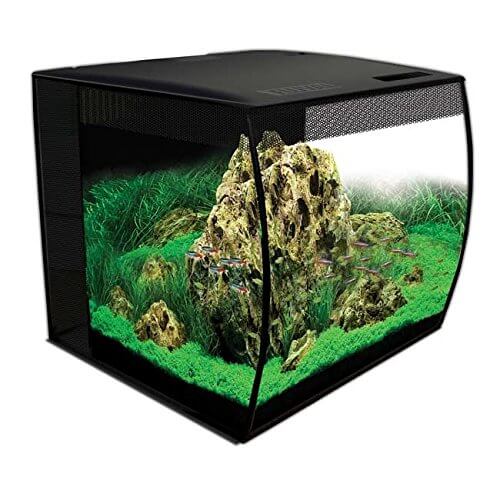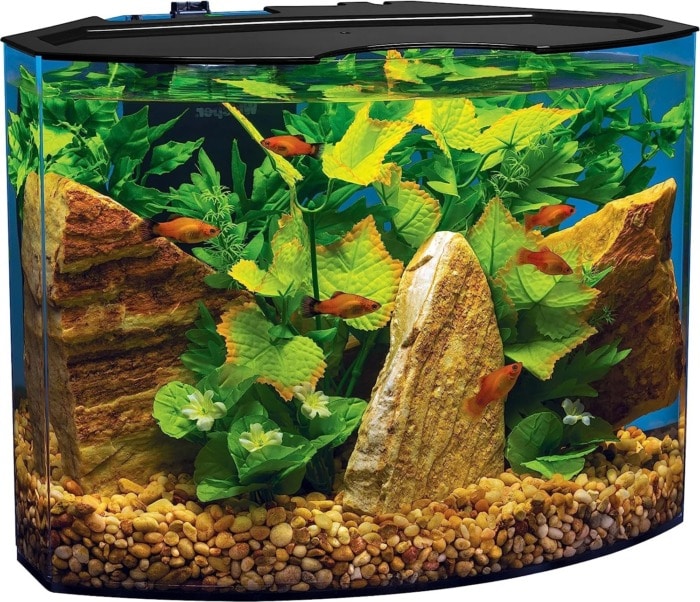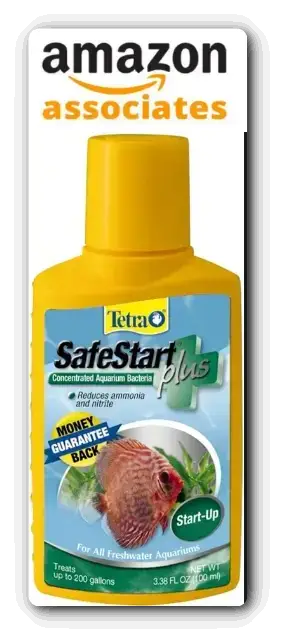Are you thinking about bringing home a Betta fish but unsure about the best tank setup? Look no further. In this comprehensive guide, we delve into the crucial factors to consider when choosing the ideal tank for your Betta friend. From tank size to equipment essentials like filters and lighting, we cover it all to ensure your Betta thrives in its new environment.

Despite its practical small size, the best 5-gallon tank for your Betta fish should include the right side equipment and not just a glossy design. Of course, so should a 10 gallon one or even a 20 gallon one, and these are, in fact, an even better choice for the fish itself.
The thing should also come with a built-in filter, proper lighting, and if you’re lucky a heater. These are mandatory and I discuss them separately in detail. So what’s the best home fish tank for your new Betta fish and is there a suitable all-in-one kit?
IN A HURRY?
If you don’t really have the time or the nerves to go through this guide I can directly point you to what I personally believe is the best choice for your little buddy’s future home if you’re just starting out.
It’s this fish tank (visit the link to see how it looks on Amazon).
The precise model I linked you to saves the hassle of researching additional gear because it basically includes almost everything one would need to start looking after a happy betta.
The only thing you’d actually need to buy separately is a heater.
If you, however, want to go more in-depth, I strongly recommend reading the reviews below.
This is because, though being small and often sold in jars a Betta needs its personal space and room for scouting.
There’s also an agreement among researchers that keeping these fish in small, unheated fish tanks results in less movement and higher mortality rates.
They are curious and sometimes antisocial little explorers.
Remember that heavily decorating an aquarium with plants, that also has a decent water capacity, is pretty much essential for these little grumpy fish.
The 11 Top-Rated Betta Fish Tanks: My Reviews
| Tank Name: | The Betta can be in: | Price Bracket: |
|---|---|---|
| 1. Tetra LED Cube Kit | 3 gallons | $$ |
| 2. MarineLand PORTRAIT | 5 gallons | $ |
| 3. Marina LED Aquarium Kit | 5 / 10 / 20 gallons | $ |
| 4. Hygger Horizon | 8-gallon tank that effectively holds 6 gallons of water | $$ |
| 5. biOrb Flow 15 | 4 or 8 gallons | $$$ |
| 6. Penn Plax RADIUS | 3.4 / 5 / 7.5 / 10 gallons | $$ |
| 7. Fluval Spec V | 5 gallons | $$$ |
| 8. Fluval Edge | 6 gallons | $$$ |
| 9. Fluval Flex 57 | 15 gallons | $ |
| 10. Tetra ColorFusion | 20 gallons | $ |
| 11. Tetra Crescent Kit | 5 gallons | $ |
A fish tank needs to have enough room for exploring interesting decorations, and a bunch of functional side equipment. The right starter-friendly setup will ensure a healthy, calm, and long-living fish. My reviews include models that are all suitable for an entry-level fishkeeper.
Take a look at the 11 best tanks that ideal for a Betta fish:
1. Tetra LED Cube Kit with Pedestal Base – Smaller Budget Option
Click here to see the current price + more photos on Chewy.
The Tetra Cube starter kit is among the best budget options for those who are super eager to start their small Betta tank. The value for the price is just outstanding though it’s nowhere near what more expensive aquariums offer.
If you end up buying this fish tank kit, know that you’ll have to invest in a heater, if it gets cold in the winter where you live.
You can read my section above about water temperature.
I did some additional research and many users recommend getting the Hydor 7.5w heater.
I’m not particularly happy with that one, so I’ll let you know what works best for my tropical fish in smaller tanks – FREESEA Submersible heater.
Anyway, aside from that, this fish tank has its own filter that does the job at first, but be prepared to upgrade to a better one later on.
The filter’s a bit too strong for the massive fins of a Betta, so make sure that you block the intake with the decor of some kind.
In fact, this is the reason I would only recommend getting this product if you’re in a hurry to start your fishkeeping journey while being tight on the budget.
For the best performance and a happy Betta, you should probably upgrade this fish tank with a more gentle filter in the future.
Speaking of side equipment, the kit also comes with LED lighting in the pack.
Frankly, the LED is weak by most standards and you won’t be able to grow many live plants with it.
Good recommendations here would be java moss, Masimo moss balls, and java fern as these are some super non-demanding species.
Anyway, I like the look of this aquarium because it’s not your conventional 3-gallon one. It has a stylish shape of a cube and despite its small size, it can be a good introduction to the hobby of keeping a single small fish.
Don’t forget to cover the feeding hole on top, by the way. Betta fish are well-known jumpers.
I’d buy this small aquarium if I were really tight on budget but were prepared to upgrade a few parts in the future. In fact, it would probably be best to upgrade to a 5-gallon one when your single small Betta outgrows this tank.
Still, I absolutely consider the Tetra Cube Kit to be in the top 10 ones.
It’s an ideal temporary option for one young Betta fish.
I’d also stuff the thing with lots of plants that require low lighting and a small piece of driftwood because the overall design allows for a really cool display planted fish tank.
Advantages:- Super duper budget friendly
- It comes with almost everything
- Made from acrylic for even better aesthetics
- The design stands out
- Does not include a heater (get this one if it gets cold in the winter where you live)
- The built-in filter is not that durable (upgrade to this inexpensive one if anything)
- Built-in LEDs can grow a limited number of plant species (Though the type of plants are limited you can still have a heavily planted nano fish tank)
2. MarineLand Portrait Glass Aquarium Kit – Pay Less for More
Click here to see the current price + more photos on Amazon.
To be honest, the Marineland Portrait Glass Aquarium is one of my personal favorites on this list.
I just can’t comprehend how the manufacturers managed to provide so much value for the money.
One of the best things about the Portrait Aquarium kit is that it comes with a 3-stage filter, that’s actually hidden at the back. The filter is strong and silent, which is a rare combination that makes up for an ideal addition to any living room.
It also has an adjustable flow, which is just gold because it minifies the water’s turbulence sparing large-finned fish the extra effort to move around.
The last two traits alone classify the MarineLand Portrait Glass as the second-best Betta fish tank with an included filter as side equipment.
The next entry will reveal my personal winner in this category, however, this one here shines with a more stylish look.
Anyway, back to the filter as I feel mentioning that I’ve found the lowest possible flow rate setting is still a bit strong for a Betta.
Just put a sponge on the intake to reduce it further and you’ll be good to go.
The lights that are included in the kit will grow low-light plants such as Java Fern and Anubias without issues, so don’t forget to add those for a more lively decoration.
The vertical design of the tank is beautiful and provides enough swimming space for an active Betta fish.
I don’t see many cons, given the price, and, perhaps, one that stands out is that the filter itself is somewhat difficult to clean.
The back area that hides the filtration system collects debris, which can prolong the establishment of the nitrogen cycle if you’re not diligent with the cleaning.
It’s just essential that you remove those timely, and it’s not that easy, really.
Aside from that, the tank kit is perfect for the money and pretty suitable for a new Betta owner.
I recommend buying this product if you’ll appreciate having one of the best and most stylish-looking fish tanks for your Betta, which’s also very silent.
All of this without really breaking the bank.
Just be sure you’re willing to stay on top of maintenance.
Note that some users report that their darkly-colored Betta fish can’t really stand out from the black background.
If yours is darkly colored (read near-black) – skip this entry as it will somewhat defeat the purpose of the whole thing.
Advantages:- Looks
- The built-in filter is silent
- The filter is hidden, so it doesn’t hinder aesthetics
- Built-in LEDs can grow low-light plants
- Inexpensive, for all that it provides
- Vertical design encourages exploring behavior and more movement
- Back chamber collects gunk and needs to be cleaned thoroughly during maintenance
- No heater in the kit (Amazon has a deal for that)
3. Marina LED Aquarium Kit – Best Side Equipment for the Money
Click here to see the current price + more photos on Amazon.
As the title goes you’ll get the best side equipment with this fish tank kit.
The Marina Aquarium kit comes in 3 sizes – 5, 10, and 20 gallons.
The price difference between them is so small that you should really get the 20 gallons one if your home or office space allows it.
However, if your budget or available space is somewhat limited, you can still buy the smallest version as it is probably the best 5-gallon choice for a Betta tank in regards to the provided value. Aside from being extraordinarily affordable, this fish tank kit comes with a filter from an established brand.
Marina is really popular in the hobby with their standalone HOB filters (Hang-on-Back) so you could expect that from them.
The filter does a fantastic job of keeping the tank clean while operating silently.
It has an adjustable flow, which is a major advantage for all-in-one fish tanks.
Another positive here would be that the built-in lights are also outstanding for the price.
In fact, I think they’re the best ones that you can get as side equipment for an all-in-one aquarium for Betta fish.
They will successfully grow a majority of low-light plants and even a few medium ones.
The LED light fixture also makes the colors of a Betta pop nicely.
You may find yourself seeing coloration that you never thought was there.
Anyway, the setup process is as beginner-friendly as it gets.
The only thing you’d want to add to this fish tank is a heater.
In conclusion, I’d buy this aquarium kit if I were new to fishkeeping and wanted to provide the best possible all-in-one setup for my Betta fish without breaking the bank.
The Marina aquarium is a safe ground for learning the hobby without endangering the well-being of a fish.
I give it a score of 10/10 and I certainly recommend it!
Advantages:- Best side equipment you will get in an aquarium kit
- The included filter keeps the water sparkling clean
- The filter is also virtually silent upon proper maintenance
- The built-in LED lighting can grow a huge variety of low-light plants
- Does not limit you to hardy live plants only
- Comes in 3 different sizes (5, 10, 20 gallons)
- Fantastic pricing for what you get
- Classic design
- Does not come with a heater
4. Hygger Horizon – The Betta Show Off Aquarium
Click here to see the current price + more photos on Amazon.
The Hygger Horizon is an excellent display fish tank with curved front glass and a 3D rockery background in which you could house no more than one Betta.
Though the tank is advertised as having a volume of 8 gallons, the background does take up space, leaving an effective swimming space of just about 6 gallons.
The realistic 3D background, however, is worth it, as it adds real depth to the whole aquarium look. It also covers less than 100% of the back wall, leaving some private space beneath it for your fish.
Combined with some densely planted aquatic plants, this little hideout works incredibly well for reducing stress in Betta fish, giving them the occasional privacy they need to have.
Speaking of plants the built-in light is rather impressive and it comes with customization options that no other aquarium kit on this list includes. You can switch between 3 different color modes, and the full-white one actually grows a wide variety of plants with low-light requirements. And let’s not forget the built-in light timer.
Another plus is that you can also tune down the intensity of the fixture, which actually allows for more flexibility with the plants.
One of the best things about the Hygger Horizon fish tank is that it comes with its own filter. The filter is rather durable and reliable for this price bracket, but the nice thing about it is that it also comes with some customization options. It has a water flow control knob that allows for adjusting the flow, which comes in handy when keeping those beautiful large-finned Betta fish.
It’s not really intuitive how to disassemble the filter when the time for changing the media comes, but it’s not hard either.
I honestly can’t say anything bad about this fish tank. The company that manufactures it is super responsive and they’re always eager to help and answer your questions. I really tried to find a valid bad experience with the Hygger Horizon, but instead, I found what clearly appears to be human error or faulty delivery. The product itself is solid.
Perhaps, the only thing that actually needs mentioning is that it’s an open-top design, so you’ll need a net of some sort to prevent your Betta from jumping out.
Buy the Hygger Horizon if you’d like to own a display Betta-friendly fish tank kit that’s easy to set up, has an impressive design, and above-average quality of the side equipment.
Advantages:- Excellent exterior design
- Easy set up if you’re a total beginner
- 3D background that adds the sense of depth
- Quiet 2-stage filter that has adjustable flow
- LED lighting with 3 color modes and intensity control
- The light grows easy aquarium plants well
- Hideout under the 3D background where your Betta fish can rest (this is helpful for reducing stress)
- No heater in the pack (Hygger actually have a good solution of their own which you can check on Amazon here)
- No lid (though not every Betta will attempt an escape, it’s good to have a safety net of some sort to prevent potential jumps)
5. biOrb FLOW Aquarium with Light – Compact & Beautiful
Click here to see the current price + more photos on Amazon.
In my opinion, the biOrb Flow fish tank has by far the coolest appearance and design of the ones listed here. It comes in 2 sizes – 4 and 8 gallons, both suitable for a Betta fish.
It’s a little pricey, but I guess it goes without saying that it would be best if you get the larger one in case you can afford it.
It has its own filter, which tends to be a bit strong for a Betta, but you can simply clamp the tubing with paper clips to reduce the flow.
I think it would be best to point out that the filter is advertised as a 5 stage one and, in fact, will filtrate each gallon of water in your new Betta tank nicely. However, only one of those stages is set for biological filtration. For this reason, I recommend stepping up your decor game. This way beneficial bacteria will have more surface area to colonize.
The LEDs of this tank kit are not the strongest out there but will allow for a couple of low-demanding live plants.
The cleaning is not that easy, but it’s not annoying either.
The only thing that this aquarium setup lacks is a heater.
Get a small aquarium heater as the Betta is a tropical fish.
The lid doesn’t have a hole for the cord of a heater, so you may need to modify it (drill a little hole, nothing more).
I’d buy this aquarium starter kit for my Betta fish if I wanted a gorgeous centerpiece for my room or a stylish addition for my overall Neo-interior design.
Nothing beats the design, and the fish tank has a sturdy build. The smaller version would be suitable for a single Betta with a couple of shrimp or snails.
Advantages:- Top-notch design (no, really, it is)
- Has a 5-stage filter and LED lights
- Setting it up is non-challenging
- Comes in 2 different sizes (4 and 8 gallons)
- The design limits you to only using biOrb equipment
- A bit pricey
- Needs a heater if you don’t live in a year-round warm climate
- Needs small one-time modifications to be fully equipped with gear
6. Penn Plax Curved Corner Glass Aquarium Kit – Affordable with Quality Filtration
Click here to see the current price + more photos on Amazon.
The Penn Plax Curved Corner Glass aquarium kit comes in 4 different sizes – 3.4, 5, 7.5, and 10-gallon tanks.
On top of that, all are pretty affordable for the value you get with each.
The bigger kit you buy – the better for your Betta, obviously.
The design is clean, nothing too special, however, it has a classy vibe to it.
Penn Plax is also a well-known brand when it comes to canister filters so I did expect that same quality in regards to the internal one you get here.
Turns out it works great and without issues.
To best describe it, I’d say that for the purpose of keeping a single Betta in this fish tank, the filter has a very simple structure that does a wonderful job for the offered sizes.
It is really more than enough to provide a decent filtration while being somewhat sturdy thanks to the simplicity of its build.
The cartridge has its own 2 chambers in which you can put custom filter media.
Anyway, you should probably know that the lighting is not that bright so it’s more of an addition for aesthetic appearance rather than a grow light for aquatic plants.
You also need to plug and unplug it every time, because there’s no on-off switch.
Therefore, I’d recommend that you stick to very low-light plants if you don’t decide on upgrading with a better fixture.
Another thing to consider as an upgrade for this setup is an aquarium heater, in case you live in a place with a chilly winter.
Anyway, the lid does not require modifications on your part when adding the heater as there’s enough space for the cord, which I think is great and rather rare with aquarium kits.
In my opinion, this is an overall great classical-looking fish tank to have your Betta in.
Buy this aquarium kit if you enjoy clean unconventional design and do not really care about growing more difficult aquatic plants.
It’s a well-justified choice for a tighter budget.
Advantages:- Round-edge glass design that’s clean yet stands out
- Comes with an internal filter that works more than well
- Comes with lights
- On the cheap side
- The light will not grow many plants
- Needs a separate heater if you don’t live in a place with a warm climate
- The filter is somewhat noisy
7. Fluval Spec V Aquarium Kit – The Smart Choice
Click here to see the current price + more photos on Amazon.
Aside from manufacturing some of the best canister filters, Fluval has stepped up its game in the nano fish tank field as well.
This small 5-gallon aquarium costs a bit more, but it’s really one of the best ones for a single Betta fish if the budget is not the limiting factor. The setup process is straightforward and you won’t really bump into any obstacles even if it’s your first time doing this.
What I really like about the fish tank is its shape though, and aesthetics is not the main factor here.
See, the longer shape allows for your Betta to actually swim around without feeling confined in the 5 gallons of water.
This way your little pet fish will have plenty to explore, especially if you load the Fluval Spec V with lots of live plants and decorations.
As with every decent aquarium kit, this one comes with its own lighting and filter. Both of these work well for the space of 5 gallons and are also rather durable.
The filter and its pump motor are enclosed, which is a plus in a small fish tank kit like this one.
The water filter filtrates without hesitation and keeps the water clean while being silent, which makes the Fluval Spec V a good addition to a living room where you spend more time.
Still, you should keep the water level in check in order to avoid splashing sounds, unless you enjoy this (some do and actually prefer it this way).
Though the current is a bit stronger for a large-finned Betta you can just stick a cheap sponge in the intake and be done with it.
The 37 LEDs are strong enough to grow most low-light aquarium plants, which is great for reducing stress levels in your Betta fish.
The fixture has a “night mode” which looks good, but is somewhat bright and may disturb the fish’s sleeping cycle.
The overall build of the fish tank is sturdy and it will last you more than other, cheaper ones.
The only thing this aquarium kit lacks is a heater (as with most aquarium kits).
A con I would like to mention is that when you get your heater, you’d need to slightly modify the lid for the heater’s cord.
It does not have a hole for that and it doesn’t look good with a half-closed lid.
Be sure to get this fish tank kit if you’re okay with paying a bit more in return for product durability and increased life quality of your Betta.
Advantages:- More horizontal space that allows for Betta fish to explore, keeping them busy
- Great LED lights for most low-demand live plants
- The filter is functional, silent and not ugly looking
- Durable build
- Price (though higher, I think it matches the quality exceptionally well)
- Easy setup even if you’re a total beginner in this kind of stuff
- Needs a separate heater if it gets cold in the winter where you live
- The water level should be maintained to avoid “splashing” sounds if you’re not into this
- The lid does not allow for additional equipment with cords (you can drill a small hole, nothing complicated or hard)
- The aquarium’s built-in filter is a bit strong for a Betta fish and needs a small sponge to the intake
8. Fluval Edge 2.0 – the Artsy Choice
Click here to see the current price + more photos on Amazon.
The guys from Fluval always go the extra mile.
With their Fluval Edge Aquarium, you get a very nifty design that suits even the most exquisite homeowner. Aside from that this fish tank kit also comes with a filter and a lighting fixture that’s perfect for a planted Betta tank.
The aquarium filter may run a bit loud before it loses all the micro air bubbles trapped inside.
You’ll need to wait that period off and eventually the noisiness will sort out itself.
You can speed that process up by tilting the filter from time to time.
It will eventually run smooth and quiet.
Anyway, the built-in LED lights are pretty impressive and allow for low to medium-demanding live aquatic plants to be grown.
Live plants in such a stylish tank look gorgeous and your Betta will love them as well.
By stuffing some green inside this aquarium you will make for a scenic exterior view on top of providing an interesting and less stressful environment for the Betta fish.
Don’t forget to add driftwood as you’ll be missing out on aesthetics otherwise.
There’s also a moonlight option to the LEDs which I do not recommend using because this way the glass reflects images from inside the fish tank.
This can stress your Betta as it may think that there’s an opponent in the tank, so it’s really best to avoid that.
The few downsides of the Fluval Edge that I could think of, are the noisy (at first) filter and the price, because this aquarium kit does not include a heater.
If you’re wondering if this is the right product for you I’d say that I would buy this fish tank for my Betta if my budget wasn’t a limiting factor and I was really into the stylish interior design of my room.
Advantages:- An absolute masterpiece in terms of design
- The filter keeps the water clean at all times
- The filter, lighting, and pump are hidden, not to interfere with the top-notch design
- The light will grow low & medium live aquarium plants
- Not a budget option
- The filter can be noisy at first (because of micro air bubbles, which will sort itself out with time)
- Moonlight option can stress a Betta (just don’t use it)
- Needs a heater
- Needs an oxygenator if you choose to keep the water level to the top (Betta fishes breathe atmospheric air and need to have some space above the water line to show up unless the water is artificially oxygenated)
9. Fluval Flex 57 Nano Glass Aquarium Kit – A Modern Design
Click here to see the current price + more photos on Amazon.
The Fluval Flex 57 comes with just about anything a Betta fish would need, except, of course, a heater.
One of the best things about the Fluval Flex aquarium is that it has a beautifully sleek design, though you won’t be able to see your Betta fish clearly from every angle because of the shape of the container. It’s advertised as a 15-gallon fish tank, but from what I’ve seen the usable living space for a fish would be just above 10 gallons.
That’s because the back hides the filter and pump and Fluval included that in their calculations for some reason.
Nevertheless, the side equipment works wonders and is reliable.
The included lighting fixture is pretty decent because it will grow a variety of low and medium-demanding plants for your Betta’s chill places.
The water filter is durable and keeps the fish tank clean, but it lacks the adjustable flow feature.
This could be an issue for Betta fish with massive fins unless you reduce the current with sponges in the intake and outlet (yes, both!).
If the current remains strong I recommend getting a separate, smaller aquarium pump that will go easy on your Betta. I looked around on Amazon and this one seems like one to do the trick.
The hidden chamber on the back of the Fluval Flex 57 provides space for extra equipment and the lid allows for extra cords to go in there, which is rare with stylishly designed aquarium kits.
I recommend buying this cool starter-pack fish tank for your Betta if you like its awesome design and your budget is not limiting you.
You may also enjoy this purchase if you want to take advantage of the decent LEDs and provide your Betta with some lush green aquarium plants, which is recommended anyway.
All in all, In my opinion, this possible is the best middle-sized aquarium for a Betta fish.
Advantages:- Hidden filter and pump in a back chamber
- Undeniably beautiful design
- LEDs will grow many low to medium-need live plants
- Has space for additional equipment and cords
- Does not include a heater
- The filter can be a bit strong for your Betta fish (you may need to replace the pump, in which case I suggest having a look at this inexpensive one)
- Pricy, considering that it provides an actual living space of 10 gallons for your fish, instead of 15
10. Tetra ColorFusion Kit – Affordable All-in-One Solution
Click here to see the current price + more photos on Amazon.
Supposedly designed to house GloFish the Tetra ColorFusion fish tank is actually a really good fit for a Betta and, perhaps, some other fish companions. It’s decently sized and though its looks are not something outstanding it is a really good beginner-level aquarium kit for new Betta owners.
It actually comes with a heater, which is a blessing, given the competitors’ aquarium kits. The included heater and the spacious 20 gallons of volume make the Tetra ColorFusion one of the best complete tank kits for a Betta fish.
The light that’s included in the pack can grow some low-tier live plants if you provide them with aquarium fertilizers.
The package actually includes plastic plants, but I think those look terrible and ugly (sorry!).
The colorful lights may stress your Betta fish so I suggest using only one constant mode and sticking to it.
The aquarium’s filter does the job as long as you’re not overstocking the fish tank, which is often tempting when you have anything above 5 gallons in volume.
Anyway, pay attention to the manufacturer’s instructions about installing the filter correctly, as many people seem to fail to do so.
It actually works nicely and quietly if you put it right and the general hint here would be to push it in harder until it clicks and fits.
The heater is a fixed temperature one, which may or may not be good for a Betta.
The one that’s included in this aquarium kit is made rather cheaply, and in my opinion, you should buy a separate unit to ensure a safe water temperature later on.
If I were you, I’d buy this fish tank If I wanted to pay less, but was prepared to compromise a little with the side accessory.
Nevertheless, the fish tank is a 20-gallon spacious one, is sturdy, made out of real glass, and overall one of the best purchases for a Betta fish. You can always upgrade some of the parts down the road and the included ones will last you for the time being.
Advantages:- You won’t worry if your Betta feels confined in 20 gallons of water
- Comes with a filter
- Only aquarium on this list that comes with a heater
- Comes with fancy lights
- Sturdy, made from real glass
- Simplistic design if you’re into that
- Affordable for an all-in-one fish tank of this size
- Side equipment is not outstanding quality, so you may want to upgrade parts later
- A rather confusing assembly process
- Colorful lights are not something you’d want to use for your Betta fish tank
11. Tetra Crescent 5-Gallon Kit – The Affrodable Simplicity
Click here to see the current price + more photos on Amazon.
The first time I got my hands on the Tetra Crescent Aquarium Kit I immediately noticed that it does not feel cheap. I expected otherwise because the price was a pretty “competitive” one.
The 5-gallon tank itself has some style to it; the front is beautifully curved, not in an obtrusive way.
The construction is acrylic which is probably one of the best material choices for a plastic tank.
Acrylic, also known as “Plexiglas”, is a sturdy type of plastic overall and it makes me happy Tetra chose it to build this kit.
The Tetra Crescent Tank seemed well-built and there was no wonky feel to it.
The overall look is what I’d call simplistic, but if that’s your first fish 5-gallon tank, it could be great for your start in the hobby.
In fact, it was obvious to me the whole Tetra Crescent Aquarium kit was made with beginners in mind.
It felt this way because the installation went smoothly and headache-free.
Both the filter and the LED light from the kit were easy to mount.
There’s obviously no heater included so you’d want to get one separately.
As for the quality of the side equipment – the filter is something I’d be okay with in a betta tank but the lighting is nothing special.
In fact, maybe don’t expect much of the included LED light.
If you decide to provide your betta with the best possible living conditions you’d want to change the light to something more reliable. That’s because you’d want to include a couple of dense live aquatic plants in the system which helps bettas feel safe and at home.
The LED light included in the Tetra Crescent Kit will NOT grow aquarium plants.
If you’re not a planted-tank-type of person then make sure to supply the system with artificial plants, caves and logs.
Your betta will explore those when you’re not around.
Advantages:- Sturdy build; acrylic construction
- Very affordable
- The filter is good
- Installation would be easy even for a complete beginner with fish tanks
- Cool curved front on a seamless tank for better observation of your pet fish
- The light in the kit is not something I’m fond of
- Tetra could’ve include a better lid since this one doesn’t seem too sturdy
Choosing the best fish tank according to volume
If available area at home is your major concern and you’ve already narrowed down your choice to a certain fish tank volume then this section is for you. I’ve made sure to arrange the reviewed products by their relative capacity bracket below. Have a look at the best Betta fish tanks in regards to gallon count:
1. Optimal small fish tanks for Betta fish
All of these are 3 or 4-gallon fish tanks that have been reviewed above in this article. Though compact, they are generally considered enough in terms of space for a Siamese Fighting Fish. Here are the best small tanks for a single young Betta fish:
- Tetra LED Cube Kit with Pedestal Base – 3 gallons.
- biOrb FLOW Aquarium with Light – 4 gallons.
- Penn Plax Curved Corner Glass Aquarium Kit – 3.4 gallons.
These are all just about the absolute minimum size for housing a single Betta with perhaps a couple of snails and nothing more. You should not buy aquariums that are smaller than that.
Of course, if your budget and available space at home allow it – get a larger fish tank and provide more swimming space for your pet buddy.
2. Optimal 5-gallon fish tanks for Betta fish
Each of these products has a separate review section above, so make sure to check that before you decide on a purchase. Have a look at the 7 best 5-gallon fish tanks for a Betta:
- Hygger Horizon -advertised as 8 gallons but holds 6, because of the 3D background.
- Penn Plax Curved Corner Glass Aquarium Kit – 5 gallons.
- MarineLand Portrait Glass LED Aquarium Kit – 5 gallons.
- Fluval Spec V Aquarium Kit – 5 gallons.
- Marina LED Aquarium Kit – 5 gallons.
- Fluval Edge 2.0 – 6 gallons, but actual water capacity is probably 5 gallons.
- Tetra Crescent 5-Gallon Kit – a simplistic and affordable 5-gallon aquarium for Bettas.
Some of these come in more than one size, so keep that in mind.
A Betta fish will not feel confined in 5 gallons of water, but will appreciate it if you provide it with more living space.
3. Optimal 10-gallon fish tanks for Betta fish
Here’s an overview of the three 10-gallon tank kits that would best suit a pet Betta:
- Penn Plax Curved Corner Glass Aquarium Kit – 10 gallons.
- Marina LED Aquarium Kit – 10 gallons.
- Fluval Flex 57 Nano Glass Aquarium Kit – advertised as 15 gallons but only provides 10 gallons of usable space.
These are all a very good fit for an entry-level Betta owner.
Make sure to read their individual reviews above before deciding on a purchase.
4. Optimal 20-gallon fish tanks for Betta fish
The selections below are ideal for a community tank with a variety of fish. They will be appreciated by your small fish pet. Take a peep at the best 20-gallon aquariums for a healthy Betta:
- Marina LED Aquarium Kit – 20 gallons.
- Tetra ColorFusion Kit – 20 gallons.
These are spacious and come with all the necessary equipment right out of the package, therefore probably the best choice of an aquarium for a happy Betta.
An A-to-Z guide to fish tanks and their role in the life of a Betta
I wish choosing the right tank was simple, but it’s not. You need to take into account everything a proper aquarium setup needs and not only. For this reason, I’ve crafted a guide that explains in detail everything you need to know before making a purchase. Here’s what you should know before buying a fish tank for your betta:
1. Finding the best size and aquarium volume for a Betta fish
Fish stores sell Betta fish in small jars or bowls. This, however, is done for display purposes and is only fine for a very short period of time. A study found that reduced environment increases aggression and stress in fish. That being said, here’s the best tank size for a Betta fish:
The absolute minimum fish tank size acceptable for a healthy Betta fish is 3 gallons. Smaller aquariums than that will result in a shortened lifespan and a poor quality of life.
A 3-gallon tank severly limits the number of stocking options and the comfort of your fish. A single Betta will best enjoy a 5 to 10-gallon fish tank but a larger one will also be appreciated.
In small fish tanks, water gets polluted very quickly which leads to an unstable environment.
Fluctuations in pH, ammonia levels, or nitrites caused by decomposing waste, are all potentially lethal to fish.
A big fish tank is (counterintuitive) way easier to maintain and the water parameters are usually more stable. This is another reason I recommend that beginners get a large aquarium, especially if the Betta is their first ever fish to adopt.
It should also be noted that in smaller fish tanks there’s less swimming space and therefore less room for exercise.
The dimensions of the tank will influence the Betta’s growth and the maximum size it can reach. Getting a bigger fish tank is always advisable.
I have a whole section where I sorted the aquariums reviewed in this article by their gallon capacity.
2. Having a filter is actually necessary
Generally speaking, an aquarium filter does 3 things in a fish tank:
- It provides mechanical filtration. This means capturing debris and small free-floating particles that make the water visually unappealing, but could also clog a fish’s gill.
- It provides biological filtration. This means providing living space to beneficial bacteria, which remove ammonia by converting it and the nitrite to other harmless molecules.
- It aerates water by moving it. Stagnant, low-on-oxygen aquarium water leads to a stressful way of life for fish and is never recommended, unless explicitly suitable for the particular species.
That being said, here’s if a Betta needs a filter in its aquarium:
Betta fish do require and will appreciate a water filter in their tank as they are not as hardy as fish stores advertise them to be. These fish produce enough waste for unfiltered water to become toxic, especially in smaller fish tanks. A good aquarium filter will also oxygenate the water, which promotes energy levels and more active swimming. Therefore the best fish tank for a Betta should include a filter.
I made sure that the aquariums listed above all include a filter for your peace of mind.
Note that Betta fish have an organ called Labyrinth, which allows them to breathe atmospheric air.
This is a survival mechanism because they are native to rice paddies.
However, breathing air should be а last resort and they will feel much more comfortable in well-oxygenated water.
3. Water current should not be too strong
If you’re going to buy a separate filter for your Betta’s fish tank anyway, don’t get one with a strong current.
Most Betta fish have enormous fins and the current may exhaust them easily.
Naturally, this can make swimming difficult and unpleasant for them.
If you already have an old filter you’d want to put to use, you can install a cylinder intake sponge to decrease water turbulence.
Getting a self-cleaning tank with an aquaponics system on top solves the current issues, while the fish tank remains free of dangerous chemical build-ups because the plants will use them up as food.
4. Lighting and what it does for the setup
Here’s why your Betta fish needs to live in a well-lit water tank:
Betta fish have their own sleeping cycle and a lighting schedule will help with normalizing it. Another reason to have lights in your fish tank is to grow aquatic plants.
Both are important factors in providing a healthy environment for a Betta fish.
If you’re new to the whole fish-keeping thing do your research on beginner-friendly plants and employ these in your new Betta aquarium.
However, aquatic plants deserve their own separate section, because…
5. Decorating with aquatic plants is essential for reducing stress levels and increasing activity
Stress from poor fish tank decoration can leave your buddy lethargic.
A common expression of that is laying on the bottom while being turned on the side.
Here’s why your Betta needs plants in its fish tank:
Betta fish are curious in their nature. The more decoration and aquatic plants their aquarium has, the more active they will be. They like to swim around, exploring stuff in the aquarium. Aquatic plants greatly reduce the stress levels of this fish so it’s best to go for a planted tank. Less stress results in longer life and a more exciting fish life in general.
I personally hate it when I see almost empty fish tanks with only 2 stones and a Betta in them.
Another thing that’s worth mentioning is that Betta fish will absolutely appreciate having personal space.
This resembles their natural habitat.
Having dense vegetation and hideouts in the aquarium provides the Betta with places to rest, should the attention from owners or tank mates becomes overwhelming.
For extra motivation, here’s a photo of a heavily planted fish tank that’s home to a beautiful blue Betta:

6. The heater maintains a tropical environment
Betta fish are tropical fish and require a constant water temperature of 75° to 82° F (24° to 28° C).
But does that mean that they require a separate heating unit?
A Betta will need an aquarium heater unless the fish tank is situated in a year-round warm location. If you live in a geolocation, where there’s cold winter and a constant water temperature of 75° to 82° Fahrenheit (24° to 28° Celcius) can’t be maintained, then supplying your Betta’s fish tank with the right size heater is vital. Set the heater to the desired temperature and don’t allow for temperature fluctuations.
Water temperature affects the behavior of Betta fish.
Unfortunately, the aquarium kits reviewed below rarely include a heater in the pack.
Luckily, I also have a guide on the aquarium heaters that would best fit 3, 5, and 10-gallon tanks.
Visit the link to check it out.
Get the larger one if you plan on keeping other fish companions
If you plan on housing your Betta fish with other fish in the near future you are absolutely responsible for making sure it all goes well.
Contrary to the popular belief it is possible, but you need to make an informed decision.
Choose Betta tank mates wisely to make sure conflict is avoided.
In that case, it’s always better to go for the larger fish tank.
If you click that link you’ll see that the companion options are heavily dependent on tank size and the density of decoration and live plants.
Note that the Betta community setup is not a recommended one if you’re a complete beginner to the hobby.
A stress-free environment is crucial for the well-being of all the aquarium inhabitants you choose to put under the same roof.
Don’t forget to wait out the nitrogen cycle before putting live fish inside
If you don’t know what a nitrogen cycle is then pause reading here and do your research now.
When the colonies are all set to handle ammonia and nitrites you can proceed with adding your Betta.
This process usually lasts a month or so, but you can speed it up by using the right brand of bottled bacteria.
My experience shows that Tetra SafeStart is a good choice for that, but you can look around if you’d like.
Some of the kits listed above do come with a bottle included, so read the contents carefully.
It’s sad how many people rush the whole fish-keeping thing just to find their new pet dead in a couple of days.
Let your new tank cycle and wait until the water parameters are safe and welcoming (0 ppm of ammonia, 0 ppm of nitrite, 10-30 ppm of nitrate) or use bottled bacteria.
Betta fish get stressed enough by being sold in jars at local fish stores.
Don’t make the rookie mistake of letting your impatience kill your new pet fish.
FAQs
What is the best type for a betta?
The best fish tank for a betta fish is the one that provides enough swimming space and interesting decorations for the fish to explore. u003cbru003eu003cbru003eExperts agree that a betta fish would feel the most comfortable in a 5-gallon tank with live plants and small cave of some sort. This closely resembles the ideal habitat of the fish in the wild.
Do betta fish prefer small or big ones?
The smallest tank you can put a betta in is a 3-gallon tank. Anything smaller than that and the fish will likely feel confined. A 5-gallon tank is a good option for a single betta, but a 10-gallon one would probably make the fish the happiest. Larger tanks like the 10-gallon one also expand your options for potential tank mates for your betta.
Is a vertical or horizontal one better for a betta fish?
Betta fish come from shallow waters in the wild. You’d want to mimic that and get a horizontal tank for your pet fish if possible.
What would betta fish like having most in one?
The best decorations to have in a Betta aquarium are live plants and a small hideout. Ideally you’d want to add some floating plants to the tank and a plant that sports large leaves near the water surface, like Anubis. u003cbru003eu003cbru003eBettas sometimes like resting on leaves near the top of the tank which is interesting to observe. The hideout should be something like an artificial cave and should act as a u0022safe spaceu0022 for your betta.
My conclusion

It’s not difficult to make the right choice for a fish home. My whole philosophy about this always was that if in doubt – let your budget decide.
Mind that all of these are aquarium starter kits, meaning that they will probably include most all side gear.
Nevertheless, I made sure none of these will be cruel to a live fish, considering the tank’s size and quality of the equipment so you won’t regret your purchase.
I tried my best to select aquariums that have a filter because this is one of the most overlooked mistakes when someone is new to fish keeping in general.
For a Betta fish to feel best in its new home, the fish tank should have the right amount of plants and decorations, be it small or big.
Tell me how things went for you in the comments below.

